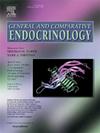Genotype for hypocretin receptor (hcrtr2) affects appetite in zebrafish
IF 1.7
3区 医学
Q3 ENDOCRINOLOGY & METABOLISM
引用次数: 0
Abstract
We investigated the role of hypocretin receptor in signaling appetite in zebrafish (Danio rerio). Hypocretin is a small neuropeptide known for its effects on circadian rhythm and appetite. Wild-type and heterozygous hu2098 (knockout for hcrtr2) zebrafish were raised to adulthood (3–4 months post fertilization) and genotyped. Feeding rate was measured directly using a novel technique that analyzed images of fish feeding continuously on brine shrimp, in which all individual brine shrimp were identified in a tank with a feeding fish. Fish were food restricted for 19–29 h before a feeding session, and feeding rate was determined by the regression of brine shrimp consumed/min over an eight-minute feeding period. Utilizing a mixed-effects ANCOVA model and accounting for mass as a covariate, heterozygous fish () ate brine shrimp at a significantly faster rate (mean 23.4 ± 12.6 shrimp/min, n = 12) than wildtype fish () (20.5 ± 13.8 shrimp/min, p = 0.033, n = 11). These results support a role for hcrtr2 in appetite regulation.
下丘脑分泌素受体(hcrtr2)基因型影响斑马鱼的食欲。
我们研究了下丘脑分泌素受体在斑马鱼(Danio rerio)食欲信号中的作用。下丘脑泌素是一种小的神经肽,以其对昼夜节律和食欲的影响而闻名。将野生型和杂合型hu2098(敲除hcrtr2)斑马鱼饲养至成年(受精后3-4 个月)并进行基因分型。采用一种新技术直接测量摄食率,该技术分析了鱼类连续摄食卤虾的图像,其中所有个体的卤虾被识别在一个有喂食鱼的水箱中。鱼在饲喂前限制进食19-29 h,摄食率由8分钟的摄食周期内消耗的卤虾/分钟的回归来确定。利用mixed-effects ANCOVA模型和会计质量作为协变量,杂合的鱼(hcrtr2 + / hcrtr2)以更快的速度吃盐水虾(平均23.4 ±12.6 虾/分钟,n = 12)比野生型的鱼(hcrtr2 + / hcrtr2 +)(20.5 ±13.8 虾/分钟,p = 0.033 n = 11)。这些结果支持hcrtr2在食欲调节中的作用。
本文章由计算机程序翻译,如有差异,请以英文原文为准。
求助全文
约1分钟内获得全文
求助全文
来源期刊

General and comparative endocrinology
医学-内分泌学与代谢
CiteScore
5.60
自引率
7.40%
发文量
120
审稿时长
2 months
期刊介绍:
General and Comparative Endocrinology publishes articles concerned with the many complexities of vertebrate and invertebrate endocrine systems at the sub-molecular, molecular, cellular and organismal levels of analysis.
 求助内容:
求助内容: 应助结果提醒方式:
应助结果提醒方式:


